Motivation and objectives
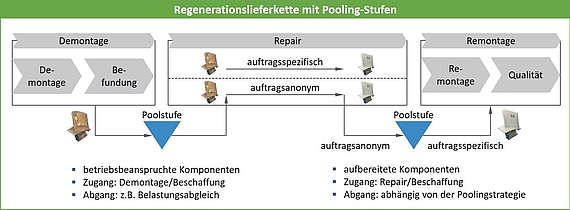
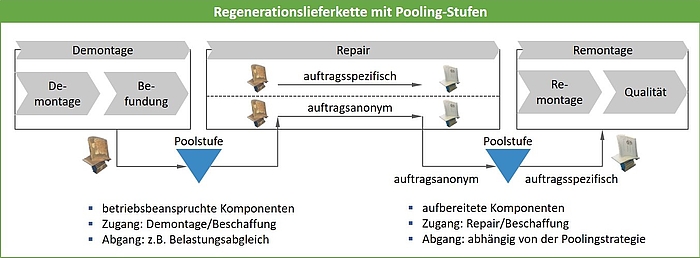
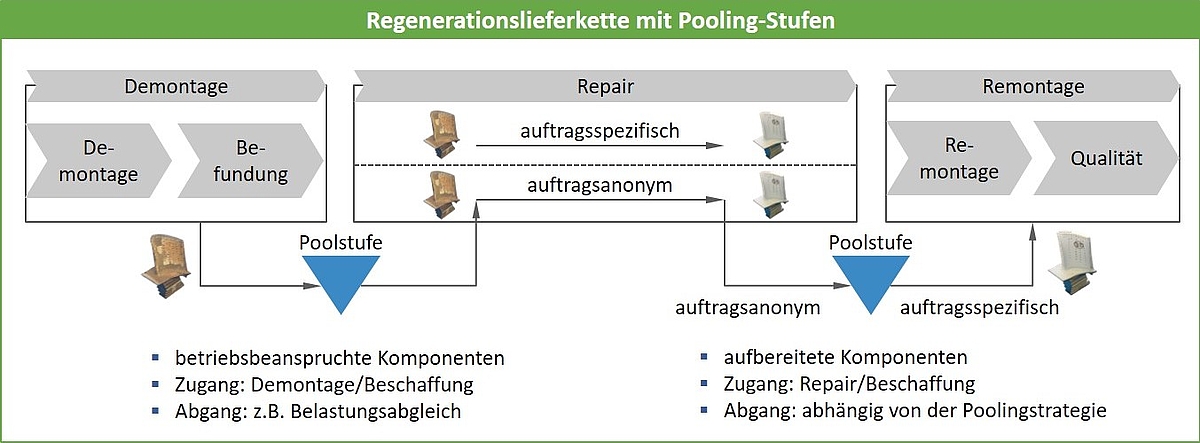
Suppliers of regeneration services face a variety of options for configuring their regeneration supply chains. Even if the configuration is defined to a certain extent by the capital good itself as well as by the technologies required for regeneration, a large number of degrees of freedom remain on the production logistics side. These lie, for example, in capacity deployment, the choice of suitable planning and control procedures, and spare parts management and the associated inventory dimensioning. Depending on the chosen configuration of the supply chain, regeneration service providers are able to offer a specific logistics service on the market. This is perceived by the customer mainly through the delivery date reliability as well as the offered delivery time. A central success factor here is the consideration of the industry-typical great uncertainty of information with regard to expected future capacity and material demands. However, so far no approach exists that allows the evaluation of different configuration measures in regeneration supply chains under the influence of various uncertainties. Therefore, a quantitative evaluation of possible and in common configurations of regeneration supply chains with respect to the achievable logistics performance as well as the resulting logistics costs shall be made possible. Therefore, among other things, evaluation models are developed on the basis of a comprehensive simulation model, which allow an evaluation of quantitative effects of different supply chain configurations on the realizable logistic as well as monetary target values
Results
In the first funding period, optimization approaches for capacity planning with short-, medium- and long-term time horizons were developed on the basis of Bayesian networks. On the basis of, for example, usage data of the capital goods, these enable more precise forecasts with regard to expected regeneration orders in the future and the resulting workload. Based on this, basic mathematical models for describing the interdependencies between design options, which can be attributed to capacity and workload coordination, and the resulting supply situation in reassembly have already been derived in the second funding period. The focus was placed on the material supply of the reassembly from repair processes, a pool stage and new parts warehouses. Consequently, a model was developed that allows an evaluation of the missing parts situation in reassembly depending on the selection and quantity of pooling components used. In the third funding period, further models were developed for the description and evaluation of configuration decisions (e.g. in the disassembly and a further pooling stage) as well as the planning behavior under the influence of information uncertainty.
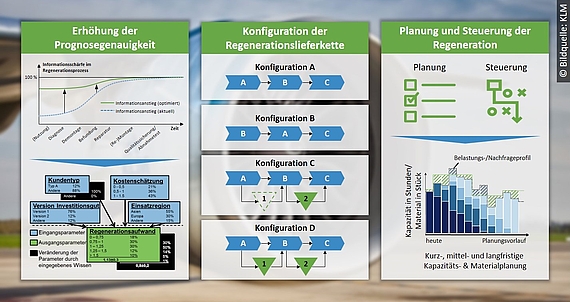
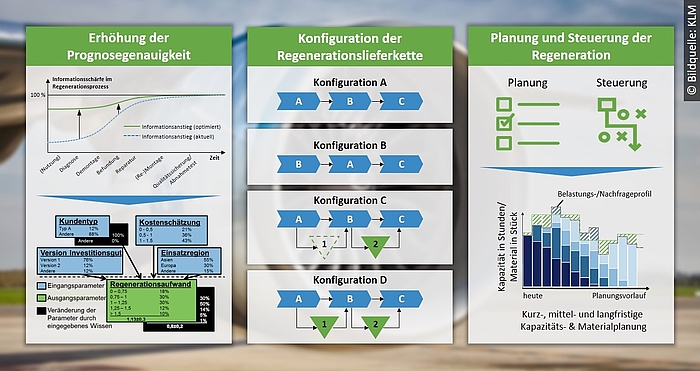
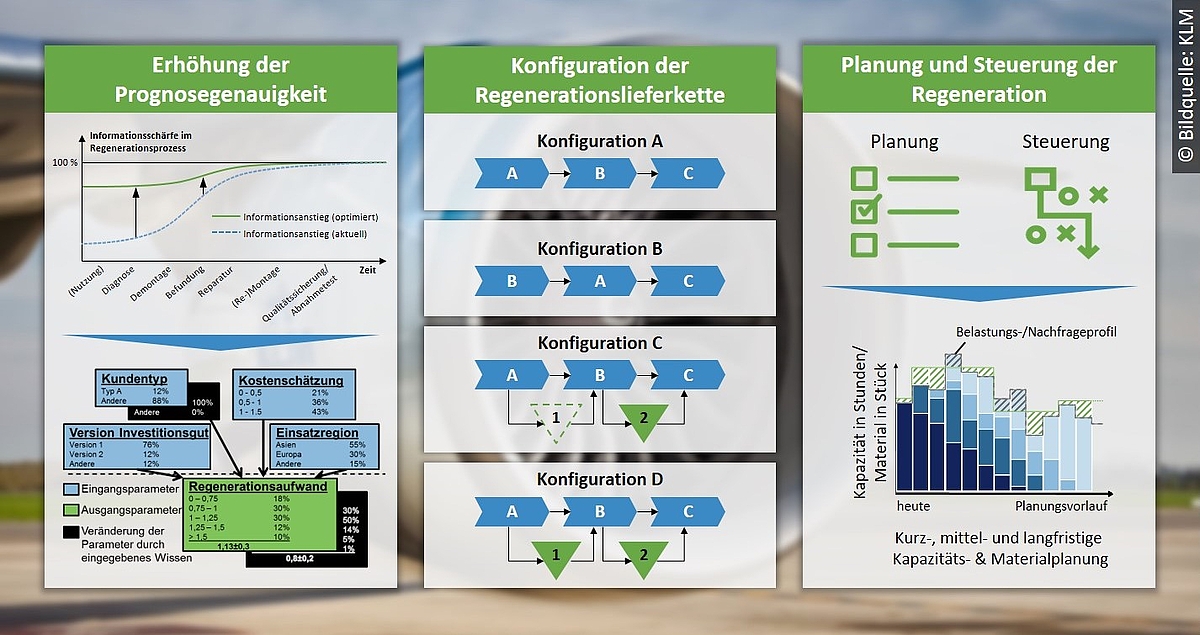
Current research and outlook
Currently, the research is being brought together in an evaluation model which, in addition to statements on process capability (supply chain structure and planning) and process reliability (control), also allows the impact of design or control changes on logistics performance and logistics costs to be evaluated without having to rely on exhaustive, use case-specific simulation studies. In addition, special focus is on the development of a model that allows the configuration and combination of multi-stage pool component inventories to design regeneration supply chains that are as robust as possible, while considering the achievable information acuity. In this context, it is also being investigated how in the future material requirements in regeneration can be better predicted and as a result further uncertainty can be removed from the regeneration process.
Subproject leader
Staff
Publications
International Scientific Journal Paper, peer-reviewed
-
(2021): Model-Based Approach for Assessing Planning Quality in Production Logistics, IEEE Access 9, S. 115077–115089
DOI: 10.1109/ACCESS.2021.3104717 -
(2020): Material Disposition and Scheduling in Regeneration Processes using Prognostic Data Mining, Procedia Manufacturing 43 (2020) 208–214
DOI: 10.1016/j.promfg.2020.02.138 -
(2020): Improving MRO order processing by means of advanced technological diagnostics and data mining approaches, Procedia Manufacturing 43, S. 688–695
DOI: 10.1016/j.promfg.2020.02.121 -
(2019): Towards an autonomous maintenance, repair and overhaul process, Procedia Manufacturing 40, S. 77–82
DOI: 10.1016/j.promfg.2020.02.014 -
(2016): Designing Capacity Synchronization within the Regeneration of Complex Capital Goods, In: Universal Journal of Management 2016 (4(10)), S. 581
DOI: 10.13189/ujm.2016.041008 -
(2014): Decision models for capacity planning in a regeneration environment, International Journal of Production Research 52 (23), S. 7007–7026
DOI: 10.1080/00207543.2014.923122 -
(2013): Validation of data fusion as a method for forecasting the regeneration workload for complex capital goods, Prod. Eng. Res. Devel. 7 (2-3), S. 131–139
DOI: 10.1007/s11740-013-0444-8
International Conference Paper, peer-reviewed
-
(2020): Regeneration Supply Chain Model and Pool Stock Dimensioning, Nyhuis, P.; Herberger, D.; Hübner, M. (Eds.): Proceedings of the 1st Conference on Production Systems and Logistics (CPSL 2020)
DOI: doi.org/10.15488/9641 -
(2020): Disassembly sequencing in the regeneration of complex capital goods, Nyhuis, P.; Herberger, D.; Hübner, M. (Eds.): Proceedings of the 1st Conference on Production Systems and Logistics (CPSL 2020)
DOI: 10.15488/9642 -
(2019): Characterization of supply chains in the regeneration of complex capital goods., Dimitrov, D., Hagedorn-Hansen, D. und Leipzig, K. von (Hg.): International Conference on Competitive Manufacturing (COMA 19), 31 January-2 February 2019, Stellenbosch, South Africa. Knowledge valorization in the age of digitalization. S. 444–449.
-
(2017): Priority based planning approaches for regeneration processes, Procedia CIRP 2017 (59), 89-94
-
(2016): Model-based analysis of reassembly processes within the regeneration of complex capital goods, In: Procedia CIRP 2016 (55), S. 206
-
(2014): From Fuzzy Maintenance, Repair and Overhaul Data to Reliable Capacity Planning, New Production Technologies in Aerospace Industry Proceedings of the 4th Machining Innovations Conference, Hannover, September 2013: Springer International Publishing Switzerland 2014, S. 181–186
DOI: 10.1007/978-3-319-01964-2_24 -
(2014): Planning the Regeneration Processes of Complex Capital Goods, Procedia CIRP 24, S. 140–145
DOI: 10.1016/j.procir.2014.08.001 -
(2010): Capacity Planning and Coordination with Fuzzy Load Information, The Business Review, Cambridge 16 (1), S. 259–264
National Scientific Journal Paper, peer-reviewed
-
(2012): Regeneration komplexer Investitionsgüter - Potenziale für Kapazitätsplanung und -steuerung sowie Auftragsannahme, Zeitschrift für wirtschaftlichen Fabrikbetrieb 2012 (10), S. 761–765
National Scientific Journal Paper, not peer-reviewed
-
(2018): Durchgängige modellbasierte Bewertung von Regenerationslieferketten, ZWF - Zeitschrift für wirtschaftlichen Fabrikbetrieb 113 (4), S. 220–224
DOI: 10.3139/104.111893 -
(2017): Bewertung von Gestaltungsoptionen in der Regeneration, ZWF - Zeitschrift für wirtschaftlichen Fabrikbetrieb 2017 (112) (6), 396-400
-
(2016): Gestaltung von Regenerationslieferketten - Bewertung der Synchronität mithilfe des Bereitstellungsdiagrammes, In: ZWF - Zeitschrift für wirtschaftlichen Fabrikbetrieb 2016 (12), 809-812
-
(2015): Konfiguration von regenerationsspezifischen Gestaltungsoptionen, Zeitschrift für den wirtschaftlichen Fabrikbetrieb 2015 (5) (110), S. 277–280
-
(2013): Mathematische Modelle zur bedarfsgerechten Kapazitätsplanung, ZWF 108 (07-08/2013), S. 552–555
-
(2012): Verfügbarkeitsoptimierung in der Kapazitätsplanung, ZWF 107 (12), S. 903–907
-
(2012): Entwicklung einer Schadensbibliothek für die Regeneration komplexer Investitionsgüter, Industrie Management 28 (2), S. 58–61
-
(2011): Ein generisches Prozessmodell für die Regeneration komplexer Investitionsgüter, ZWF 106 (11), S. 861–865
-
(2010): Kapazitätsplanung und -abstimmung bei unscharfen Belastungsinformationen, ZWF 105 (4), S. 323–327
Dissertationen
-
(2018): Modellgestütztes Ersatzteilmanagement in der Regeneration komplexer Invstitionsgüter, Garbsen: TEWISS Verlag
-
(2014): Kapazitätsplanung und -abstimmung für die Regeneration komplexer Investitionsgüter, Leibniz Universität Hannover, Garbsen: Berichte aus dem IFA
ISBN: 978-3-944586-77-9 -
(2012): Grundmodell zur Kapazitäts- und Belastungsabstimmung eines Arbeitssystems in der Regeneration, Berichte aus dem IFA, Garbsen 2012
ISBN: 978-3-943104-60-8




